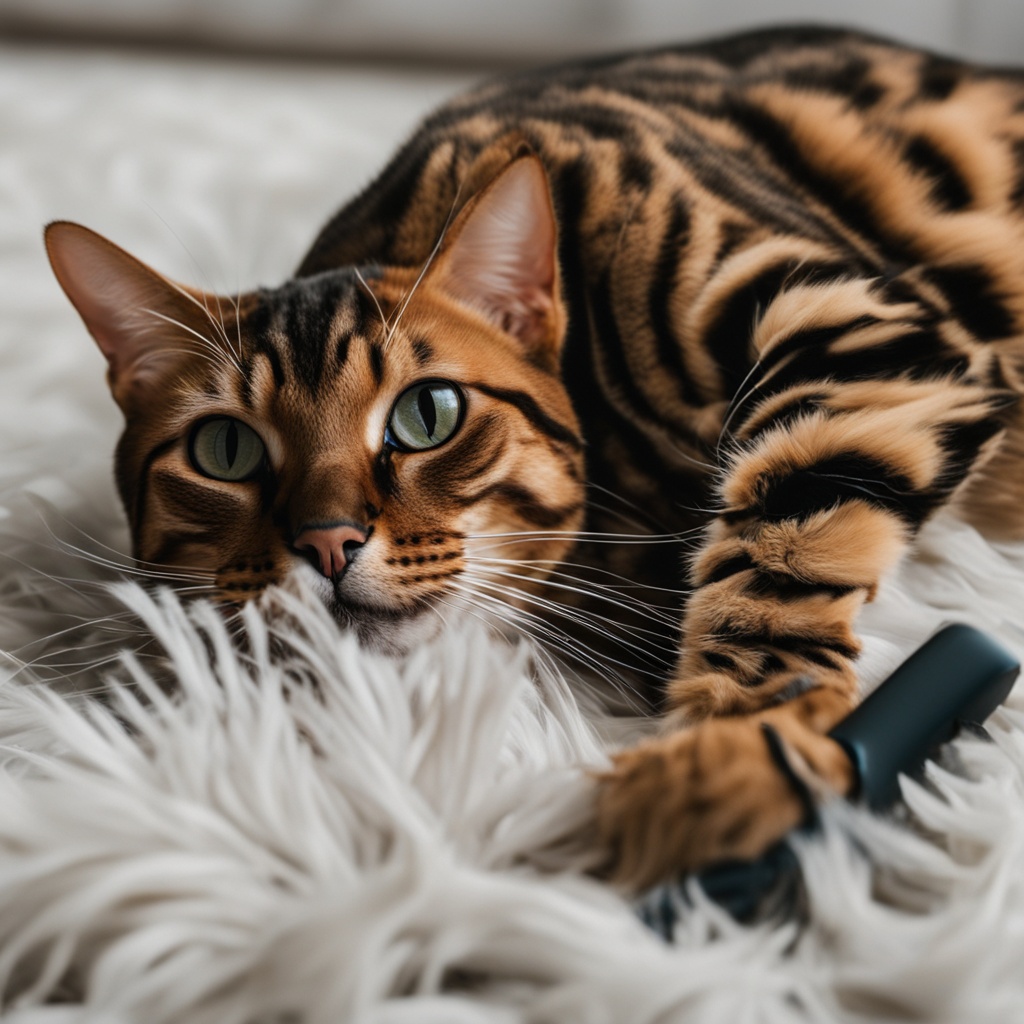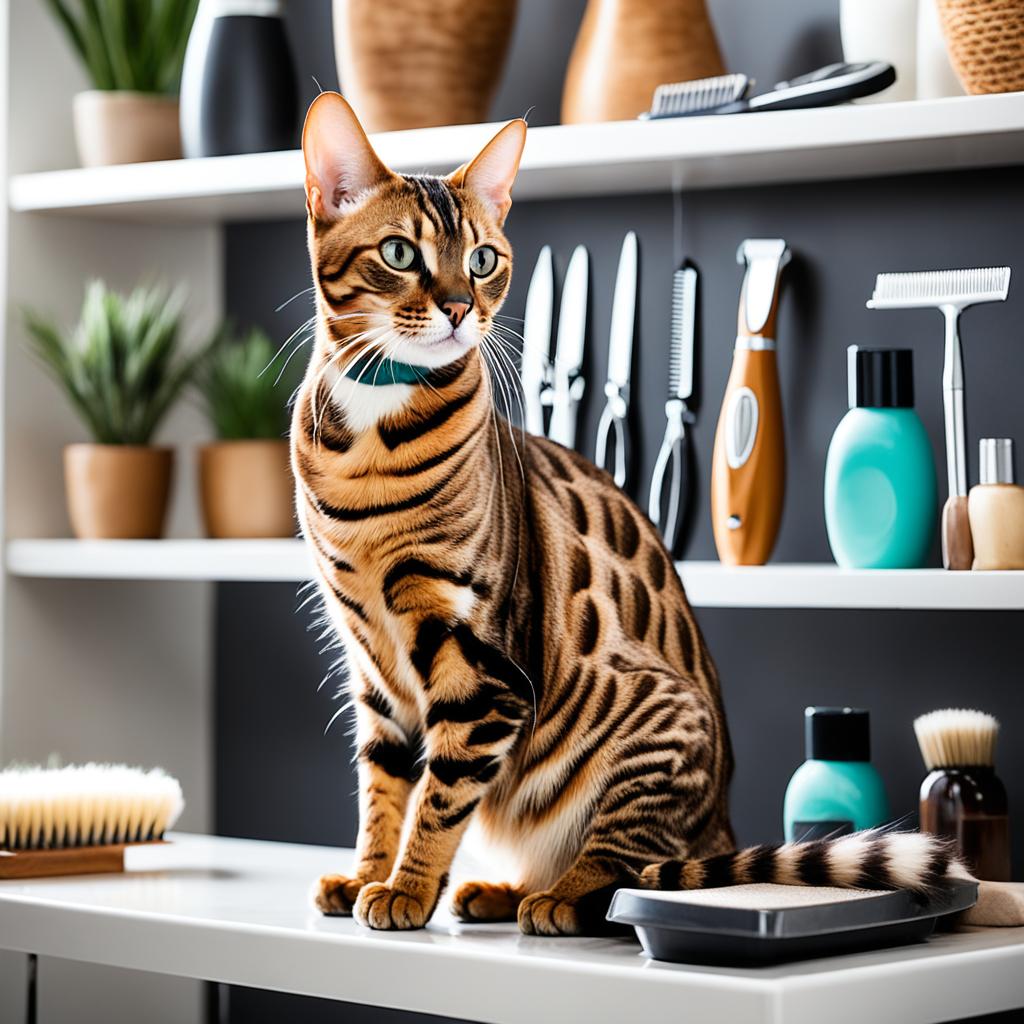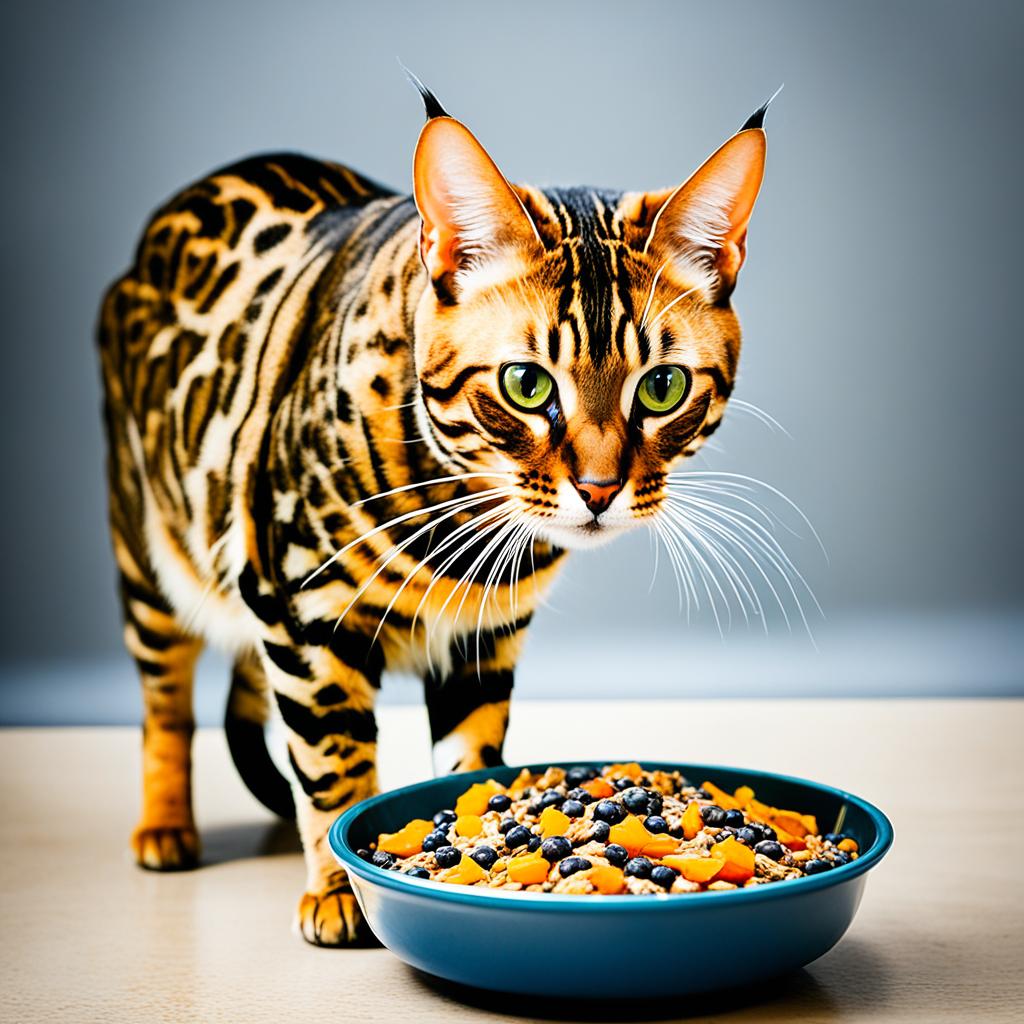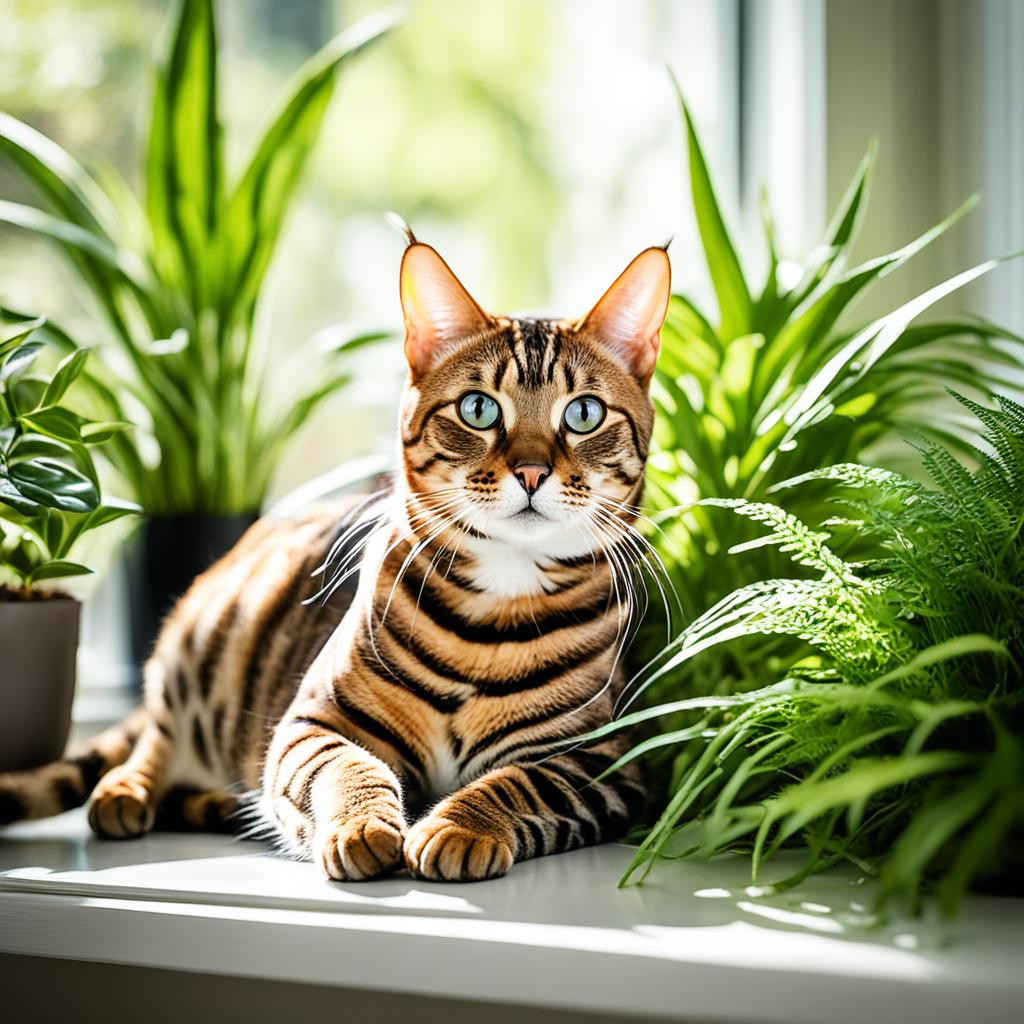Tired of finding fur everywhere in your house? Bengal cats are known for their beautiful looks and active nature. But this also means they shed quite a lot. So, what’s the secret to handling Bengal cat shedding and keeping your cat happy and healthy?
Bengal cats are full of energy and intelligence. This makes them need mental and physical challenges to avoid bad habits and excessive shed hair. By keeping them busy in the right ways, you can reduce their shedding. So, let’s learn about proper grooming, the right diet, and how their living environment affects shedding. These steps will help you minimize the shedding and keep your cat’s fur in great shape. Say hi to a cleaner home without the hassle of excess fur!
By grooming your cat often, feeding them well, and making their home a stress-free zone, you can cut down on shedding. These tips are the key to less fur around your place!
Key Takeaways
- Ensure your Bengal cat receives plenty of mental and physical stimulation.
- A proper, balanced diet is crucial for controlling shedding.
- Implement regular grooming practices to manage loose hair.
- Maintain a calm environment to reduce stress-induced shedding.
- Monitor your Bengal cat’s health for any underlying issues that may cause excessive shedding.
Understanding Why Bengal Cats Shed

Bengal cats are well-known for their unique, short, and thick fur. They come in various colors and have distinctive patterns. Even with their special look, they shed similar to other cats. They might also shed more at different times of the year due to their wild background.
Many things can make Bengal cats shed more. Health problems like skin issues or allergies might be a cause. What they eat is crucial too. A diet that lacks the right nutrients could make their fur come out more.
- Stress is also a big factor in shedding. Big changes like moving to a new home can stress them out. This leads to more shedding.
It’s important to know about these shedding factors. This understanding helps us take good care of Bengal cats and their beautiful coats.
How to Deal with Shedding in Bengal Cats?

To tackle Bengal cat shedding, understand the reasons behind it and lessen them. This includes regular grooming and feeding them well. Also, keeping their stress low and providing a stable home helps a lot.
“A happy cat is a less sheddy cat.” — Someone Wise
- Grooming: Brushing your Bengal cat often is key to reducing shed fur. The right tools can help stop fur from spreading in your home.
- Nutrition: A balanced diet rich in nutrients is vital. Ensure they get enough protein and healthy fats to lessen shedding.
- Stress Management: Stress can cause too much shedding. So, create a peaceful home for your cat with plenty of fun activities.
- Observation: Watch your cat’s behavior closely. Early spotting of stress might prevent serious shedding problems like overgrooming.
For Bengal cats, keeping a check on their health is vital in shedding control. Every effort you make adds up, ensuring a happy, healthy Bengal kitty with minimal shedding.
Regular Grooming for Bengal Cats

Grooming your Bengal cat regularly is key. It helps manage shedding and keep their coat healthy. With the right *best practices for Bengal cat shedding*, you can lessen the fur in your home.
Brushing Techniques
Using the correct brushing methods is vital. Brush your Bengal cat gently and in the hair’s natural direction. This removes loose hair without discomfort. Good brushing techniques also help spread their natural oils, making their coat shiny and healthy.
Choosing the Right Brush
Picking the right brush matters a lot for *Bengal cat grooming for shedding*. For their dense, short fur, use a slicker brush or a grooming glove. These are gentle on their skin but effective in removing loose fur and decreasing shedding.
| Brush Type | Benefits |
|---|---|
| Slicker Brush | Excellent for removing loose hairs and preventing mats |
| Grooming Glove | Great for a gentle, massage-like grooming experience while collecting shed fur |
| Bristle Brush | Helps distribute natural oils for a shinier coat |
Following these *best practices for Bengal cat shedding* will make both you and your cat happier and healthier. The right tools and methods turn grooming into quality time with your pet.
Diet and Nutrition to Reduce Bengal Cat Shedding

Maintaining your Bengal cat’s beautiful coat is key, and diet is vital. A balanced diet helps reduce shedding a lot. So, feeding your cat right can make a big difference.
Essential Nutrients for Healthy Fur
A good diet for your Bengal should be full of key nutrients. These nutrients help keep their fur healthy and lessen shedding. Foods rich in animal proteins are a must. They help build a strong coat. Also, fats from animals are important. They keep the skin and fur shiny.
Supplements that Help Control Shedding
Adding certain supplements to your Bengal’s food can cut down shedding. Omega-3 fatty acids are amazing for the skin and coat. They help keep your cat’s fur full, thick, and vibrant. This reduces shedding too.
Regular Vet Check-ups

Taking your Bengal cat for regular vet visits is key to their health and managing shedding. Vet check-ups help to find and treat any health problems early. This is important for reducing shedding. Keeping your cat healthy means less shedding.
Identifying Health Issues
Vets are skilled at spotting health issues that could make your cat shed more. Things like allergies or infections are often the cause. Finding these issues early is crucial. It lets you start fixing them right away. Remember, it’s better to prevent problems than to fix them later.
Parasite Control
Fleas and mites don’t just bother your cat, they can make your cat shed more, too. It’s crucial to keep them away with regular anti-flea treatments. This is a big part of managing a Bengal cat’s shedding. It also keeps your cat feeling good and looking its best.
| Health Check-up Component | Importance |
|---|---|
| Regular Vet Visits | Maintains overall health and early detection of shedding issues |
| Identifying Allergies | Reduces discomfort and associated shedding |
| Parasite Control | Prevents pests that cause irritation and hair loss |
Hydration and Skin Health

Proper hydration is key for a Bengal cat shedding remedy. It helps keep their skin and fur healthy and reduces shedding. It’s critical your cat drinks enough water to keep its coat looking good.
Cats often don’t drink enough water. So, what can you do to help them stay hydrated? Try these tips:
- Provide plenty of fresh water throughout the day.
- Consider using water fountains as cats love the sight and sound of running water.
- Incorporate wet food into their diet to increase moisture intake.
- Add a splash of tuna juice or clam juice to their water bowls to make it more enticing.
Keeping your cat hydrated is vital for its skin. When your Bengal cat’s skin stays moisturized, shedding is less. A vigilant hydration plan is key for a beautiful Bengal coat.
Now, let’s look at the benefits of different ways to keep cats hydrated:
| Method | Advantages | Disadvantages |
|---|---|---|
| Water Bowls | Widely available, easy to refill | May not encourage sufficient drinking |
| Water Fountains | Encourages more drinking, adds enrichment | Requires regular cleaning and maintenance |
| Wet Food | Boosts hydration, nutritional benefits | Higher cost, needs balanced diet inclusion |
| Flavored Water | Increases water intake | Pending approval from your vet |
Use these ways to keep your Bengal cat hydrated. Creating a good drinking environment is a top Bengal cat shedding remedy. This approach is key in reducing your Bengal cat’s shedding.
Environmental Factors and Shedding

Bengal cats shed a lot despite their beautiful coats. But, did you know that where they live affects how much they shed? Knowing how to deal with shedding in Bengal cats is key to keeping your home clean and your kitty content.
The weather and the light in your home do play a big role in your cat’s shedding. If it suddenly gets colder, your Bengal might start shedding more, even if it’s not shedding season. So, don’t be surprised if you see more fur when you turn the heat on in winter.
Keeping the room at a stable temperature can help. Also, a humidifier might be good for Bengal cats living in dry places. It helps keep their skin moist, reducing the chance of irritation and excessive shedding.
Sunlight is important too. Cats who spend time in the sun usually have softer coats, thanks to how sunlight helps their skin and fur. Too much direct sunlight, though, can be bad for them. When thinking about how to deal with shedding in Bengal cats, focus on getting them enough light without overheating them.
| Environmental Factor | Impact on Shedding | Solution |
|---|---|---|
| Temperature | Sudden changes can trigger shedding | Maintain a stable indoor climate |
| Humidity | Low humidity can lead to dry skin and increased shedding | Use a humidifier |
| Natural Light | Regulates hormones and impacts skin health | Ensure ample daylight exposure |
Your home’s setup is crucial for your Bengal’s shedding. By controlling these factors, you can really help your kitty. A well-managed environment is a great Bengal cat shedding remedy. It leads to a cleaner home and a happier, healthier cat.
Stress Management for Your Bengal Cat
Stress can cause Bengal cats to shed more and groom excessively. To help your cat, make your home a peaceful place. This keeps your Bengal calm, reducing their need to groom too much.
Creating a Calm Environment
Design a peaceful living space for your Bengal. Ensure they have hiding places and cozy corners. This helps if they get too stimulated. Keep the environment quiet to help keep your Bengal from overgrooming and shedding.
Interactive Toys and Playtime
Play with your Bengal using interactive toys for their well-being. This is great for their physical and mental health. Toys like puzzle feeders and feather wands will keep them happy. Regular play and a good schedule will help manage their shedding.
Making these changes will lower your cat’s stress and make their fur better. A happy Bengal means less shedding in your home.




